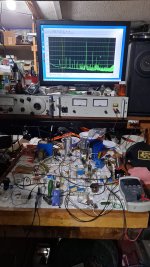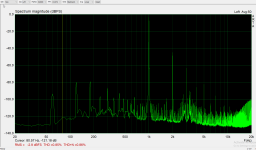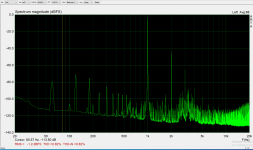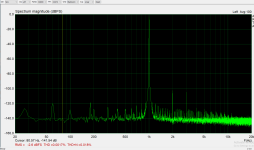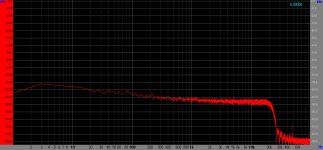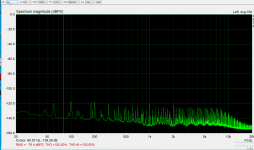"Driver" is the driver output to the grid of the 300B. "EH2_1W" is the one watt output at the load resistor.
I mean a summary of previous measurements and new measurements just to see if the soundcard/software makes a difference.
My opinion is that in order to evaluate an Amplifier SE 300b should be measured at 7w in the secondary OT"Driver" is the driver output to the grid of the 300B. "EH2_1W" is the one watt output at the load resistor.
Are you sure, that measuring set is correct?"Driver" is the driver output to the grid of the 300B.
There is significant hum, which is spreads in the whole spectrum.
Try to measure with only shorted input soundcard (as reference), and later driver output (+ buffer for soundcard) with shorted input amplifier. Compare the two measurement.
Try to measure amplifier self noise (shorted input).
No, it is a breadboard. I don't care about 60Hs and it's harmonics. Those can be adressed in the power supply design.
The power supply is a HP 6448B with a cap multiplier (FET) for the driver tube.
The breadboard will pick up radiated noise. Including 60HZ and harmonics.Skip the 60/120/180/240...hz noise.
Lets stay with THD and IMD for the output.
The power supply is a HP 6448B with a cap multiplier (FET) for the driver tube.
The breadboard will pick up radiated noise. Including 60HZ and harmonics.Skip the 60/120/180/240...hz noise.
Lets stay with THD and IMD for the output.
Attachments
So, stay with THD of the whole amp. My question was: how does it compare now with the old set-up? Is it the same, better, worse? I am not sure about the numbers to compare.
The test of the test setup is always suggested as first step
In this circuit the input stage running fine so it can be skipped
If a good generator is available with 10 volt (p.e.) as signal to drive the input of power stage then it will possible to get the signal from anode of 300B ( with proper coupling cap and resistors attenuator)
the gain is around 3-4 times so it is a minimum to understand the thd shape
Walter
In this circuit the input stage running fine so it can be skipped
If a good generator is available with 10 volt (p.e.) as signal to drive the input of power stage then it will possible to get the signal from anode of 300B ( with proper coupling cap and resistors attenuator)
the gain is around 3-4 times so it is a minimum to understand the thd shape
Walter
First plot - 76Vrms measured at the anode of the 300B, capacitively coupled to a resistor divider to the sound card.
Second plot - same conditions but measured at the load resistor on the transformer output.
Second plot - same conditions but measured at the load resistor on the transformer output.
Attachments
IMHO your measuring set (PC+soundcard) lies, the tremendous IMD products due to its.Try to measure with only shorted input soundcard (as reference), and later driver output (+ buffer for soundcard) with shorted input amplifier. Compare the two measurement.
Try to measure amplifier self noise (shorted input).
If the self test (shorted input soundcard) FFT is correct, try to measure driver section.
Sample for comparison:
Breadboarded (CCS loaded 841, 10Y as CF) driver output at 70V RMS (on the grids of PSE 801a).
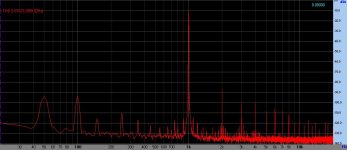
Sound-card loop-back.
I believe what you see is probably power supply harmonics, not IMD. Look closely at the 1KHz tone and the 60/120/180...Hz side-bands are very low indicating low IMD.
I believe what you see is probably power supply harmonics, not IMD. Look closely at the 1KHz tone and the 60/120/180...Hz side-bands are very low indicating low IMD.
Attachments
Last edited:
"Internal Asus Strix Raid DLX"
... and PC switching supplies and bus noise.
It's can intermodulate signal components.
Try to kill all other applications when measurement is taking.
I use dedicated -old- laptop- for measurement and external soundcard.
For single tone measurement I use special (low noise) 1kHz and 10kHz clock (Victor's).
Sample: 1kHz external oscillator, EMU0404 USB measurement.
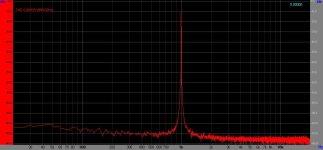
For soundcard measurement it's better than internal source.
Another good sine source is appropriate.
https://www.diyaudio.com/community/...tor-for-thd-measurements.394993/#post-7258655
... and PC switching supplies and bus noise.
It's can intermodulate signal components.
Try to kill all other applications when measurement is taking.
I use dedicated -old- laptop- for measurement and external soundcard.
For single tone measurement I use special (low noise) 1kHz and 10kHz clock (Victor's).
Sample: 1kHz external oscillator, EMU0404 USB measurement.

For soundcard measurement it's better than internal source.
Another good sine source is appropriate.
https://www.diyaudio.com/community/...tor-for-thd-measurements.394993/#post-7258655
- Home
- Amplifiers
- Tubes / Valves
- 300B with high harmonic distortion
